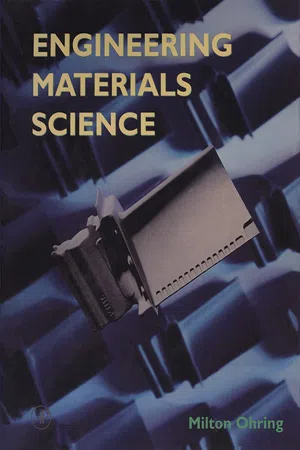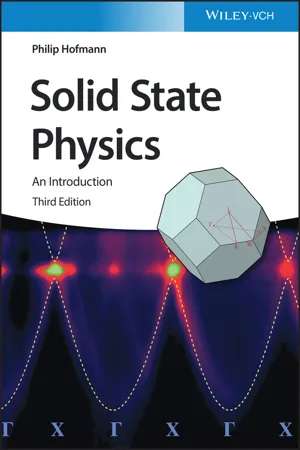Physics
Ordered Structure
An ordered structure refers to a system that has a specific arrangement or pattern. In physics, this can refer to the arrangement of atoms or molecules in a crystal lattice, which determines the properties of the material. The ordered structure can also affect the behavior of waves and particles within the material.
Written by Perlego with AI-assistance
Related key terms
Related key terms
1 of 4
Related key terms
1 of 3
4 Key excerpts on "Ordered Structure"
- eBook - ePub
- Milton Ohring(Author)
- 1995(Publication Date)
- Academic Press(Publisher)
3STRUCTURE OF SOLIDS
3.1 INTRODUCTION TO CRYSTAL STRUCTURE
Although the previous chapter developed models of solids based on the electronic structure of atoms, it was largely done without assumptions as to how atoms were physically arranged or positioned relative to each other. In this chapter an almost opposite viewpoint is adopted: the physical structure is our primary concern and the electronic structure is of secondary interest. Of course, at a deeper level the two types of structures are intimately coupled. The richness in the diversity of materials properties is attributable to the countless combinations of different atomic species, their electronic constitution, and the way atoms are geometrically arranged within solids.It is convenient to subdivide the structure of solids into two broad categories: crystalline and noncrystalline or amorphous . Many solids have a crystalline structure that is described by an ordered geometric array of atoms that stretches endlessly in all directions in a repetitive fashion. We do not think of materials like structural steel and solder as being crystalline because they are not clear, transparent, faceted, sparkling, angular, and so on. Despite external appearances to the contrary, materials like metals are, in fact, crystalline based on the scientific criterion of an orderly internal arrangement of atoms. On the other hand, atoms are not positioned in predictably ordered arrays in amorphous solids like silica glass and most hydrocarbon polymers.In this chapter we are concerned with a description of the structure of crystalline solids. Although crystals have been known, and some even fondled for thousands of years, it is only in the last century that they have been classified. To create actual crystal structures one must first imagine a three-dimensional array of points in space distributed such that each has identical neighbors. There are only 14 ways to arrange points in space having this geometrical property. These special point arrays are known as Bravais point lattices . It must be appreciated that the space of any one of these point lattices can be delineated into cells in a number of arbitrary ways. The lines drawn in Fig. 3-1 have been found to be the most convenient way to outline unit cells of points that can be used to distinguish each of the Bravais lattices. Table 3-1 summarizes the lengths and interaxial angular relationships among the 14 unit cells that can be further classified as belonging to one of seven crystal systems. The unit cell dimensions, a , b , and c are known as lattice parameters - eBook - ePub
- J. R. Hook, H. E. Hall(Authors)
- 2013(Publication Date)
- Wiley(Publisher)
CHAPTER 1
Crystal structure
Beauty when uncloth’d is clothè d best.—Phineas Fletcher (1582–1650)1.1 INTRODUCTION
The aim of solid state physics is to explain the properties of solid materials as found on Earth. For almost all purposes the properties are expected to follow from Schrödinger’s equation for a collection of atomic nuclei and electrons interacting with electrostatic forces. The fundamental laws governing the behaviour of solids are therefore known and well tested. It is nowadays only in cosmology, astrophysics and high-energy physics that the fundamental laws are still in doubt.In this book we shall be concerned almost entirely with crystalline solids, that is solids with an atomic structure based on a regular repeated pattern, a sort of three-dimensional wallpaper. Many important solids are crystalline in this sense, although this is not always manifest in the external form of the material. Because calculations are easier, more progress has been made in understanding the behaviour of crystalline than of non-crystalline materials. Many common solids—for example, glass, plastics, wood, bone—are not so highly ordered on an atomic scale and are therefore non-crystalline. Only recently has progress been made in understanding the behaviour of non-crystalline solids at a fundamental level.†Even in the restricted field of crystalline solids the most remarkable thing is the great variety of qualitatively different behaviour that occurs. We have insulators, semiconductors, metals and superconductors—all obeying different macroscopic laws: an electric field causes an electric dipole moment in an insulator (Chapter 9), a steady current in a metal or semiconductor (Chapters 3 to 6) and a steadily accelerated current in a superconductor (Chapter 10). Solids may be transparent or opaque, hard or soft, brittle or ductile, magnetic or nonmagnetic.In this chapter we first introduce in Section 1.2 the basic ideas of crystallography. In Section 1.3 we describe some important crystal structures and in Section 1.4 we explain how x-ray diffraction is used to determine crystal structure. In Section 1.5 we discuss quasi-crystals, ordered solids that challenge much of the conventional wisdom concerning crystalline materials. Section 1.6 contains a qualitative description of the interatomic forces responsible for binding atoms into solids. - R. E. Smallman, R J Bishop(Authors)
- 1999(Publication Date)
- Butterworth-Heinemann(Publisher)
Chapter 2Atomic arrangements in materials
2.1 The concept of ordering
When attempting to classify a material it is useful to decide whether it is crystalline (conventional metals and alloys), non-crystalline (glasses) or a mixture of these two types of structure. The critical distinction between the crystalline and non-crystalline states of matter can be made by applying the concept of ordering. Figure 2.1a shows a symmetrical two-dimensional arrangement of two different types of atom. A basic feature of this aggregate is the nesting of a small atom within the triangular group of three much larger atoms. This geometrical condition is called short-range ordering. Furthermore, these triangular groups are regularly arranged relative to each other so that if the aggregate were to be extended, we could confidently predict the locations of any added atoms. In effect, we are taking advantage of the long-range ordering characteristic of this array. The array of Figure 2.1a exhibits both short- and long-range ordering and is typical of a single crystal. In the other array of Figure 2.1b , short-range order is discernible but long-range order is clearly absent. This second type of atomic arrangement is typical of the glassy state.1Figure 2.1 Atomic ordering in (a) crystals and (b) glasses of the same composition(from Kingery, Bowen and Uhlmann, 1976 ; by permission of Wiley-Interscience).It is possible for certain substances to exist in either crystalline or glassy forms (e.g. silica). From Figure 2.1 we can deduce that, for such a substance, the glassy state will have the lower bulk density. Furthermore, in comparing the two degrees of ordering of Figures 2.1a and 2.1b- eBook - ePub
Solid State Physics
An Introduction
- Philip Hofmann(Author)
- 2022(Publication Date)
- Wiley-VCH(Publisher)
1 Crystal StructuresOur general objective in this book is to understand the macroscopic properties of solids on a microscopic level. In view of the many particles in solids, coming up with any microscopic description appears to be a daunting task. It is clearly impossible to solve the equations of motion (classical or quantum‐mechanical) of the particles. Fortunately, it turns out that solids are often crystalline, with the atoms arranged on a regular lattice, and this symmetry permits us to solve microscopic models despite the vast number of particles involved. In a way, this situation is similar to atomic physics where the key to a quantum‐mechanical description is the spherical symmetry of the atom. We will often imagine a macroscopic solid as one single crystal, a perfect lattice of atoms without any defects whatsoever. While it may seem that such perfect crystals are not particularly relevant for real materials, this is in fact not the case. Many solids are actually composed of small crystalline grains. Such solids are called polycrystalline, in contrast to a macroscopic single crystal, but the number of atoms within a perfect crystalline environment in them is still very large compared to the number of atoms on the grain boundary. For instance, for a grain size on the order of atomic distances, only about 0.1% of all atoms are at the grain boundaries.There are, however, also solids that are not crystalline. These are called amorphous. The amorphous state is characterized by the absence of any long‐range order. There may exist, however, a degree of short‐range order between the atoms.This chapter is divided into three parts. In the first part, we define some basic mathematical concepts needed to describe crystals. We keep things simple and mostly use two‐dimensional examples to illustrate the ideas. In the second part, we discuss common crystal structures. For the moment, we will not ask why the atoms bind together in the way they do – this topic will be discussed in Chapter 2
Index pages curate the most relevant extracts from our library of academic textbooks. They’ve been created using an in-house natural language model (NLM), each adding context and meaning to key research topics.
Explore more topic indexes
Explore more topic indexes
1 of 6
Explore more topic indexes
1 of 4



